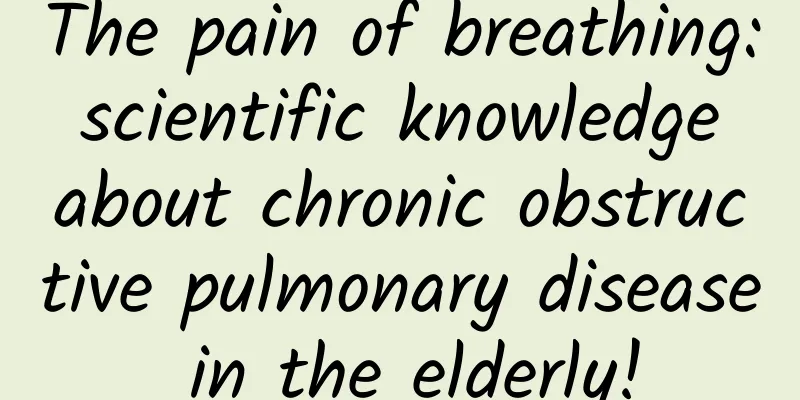The pain of breathing: scientific knowledge about chronic obstructive pulmonary disease in the elderly!

|
Mr. Li is 82 years old this year. He likes to exercise. He goes to a nearby park to exercise every morning and after dinner. He has persisted for more than ten years. In the past two years, he found that his physical condition has declined. He has symptoms such as chest tightness and wheezing after exercise. After going to the hospital for examination, he was diagnosed with COPD. Mr. Li thought that he had always been in good health and had no obvious signs of illness. How could he have COPD? He was confused and had many questions in his heart. He asked many questions to the attending doctor. Q: What is COPD? A: COPD is a common respiratory disease with a high incidence in the elderly. The disease is characterized by airflow limitation, which causes patients to cough, expectorate, and have difficulty breathing. Some patients also experience chest tightness and wheezing, which seriously affects their daily lives and is extremely harmful. COPD has a long course and is prone to relapse. It requires long-term treatment for patients and the cooperation of elderly COPD patients is required. Q: What are the causes of COPD? A: The exact cause of COPD is still unclear, and it is the result of multiple factors. The pathological and physiological changes in COPD patients are airflow limitation and airway obstruction, which are related to the individual susceptibility factors of the patient and environmental factors. 1. Long-term smoking is one of the most common causes of COPD. In addition, long-term inhalation of occupational dust and chemical gases can also increase the risk of COPD. 2. COPD has a certain genetic susceptibility. Age is a risk factor for COPD, and the probability of developing COPD increases with age. 3. Lung growth may also affect the formation of COPD. For example, direct or indirect exposure to harmful factors during pregnancy, birth, and adolescence can have a direct impact on lung growth, leading to poor lung growth and development, which will increase the risk of COPD. 4. Airway hyperresponsiveness and bronchial asthma can induce COPD. Asthma is one of the risk factors for COPD and can also coexist with COPD, aggravating the condition. Airway hyperresponsiveness is involved in the pathogenesis of COPD and is the main risk factor for COPD. 5. Low body mass index is related to COPD. The lower the body mass index, the higher the incidence rate. 6. In addition, smoking and body mass index interact with COPD. Air pollution, infection, chronic bronchitis, etc. are all factors that induce COPD, which need to be taken seriously by elderly patients, who should correct bad living habits as soon as possible and actively treat the primary disease. The picture comes from the Internet Q: What are the typical symptoms of COPD? How to identify them? Answer: 1. Typical symptoms of COPD include cough, sputum, and difficulty breathing. They lack specificity and are easily confused with other respiratory diseases, which reduces the attention paid to COPD and delays its treatment. 2. Some elderly COPD patients have no obvious symptoms in the early stage of the disease, but they will gradually develop symptoms as the disease progresses, and the symptoms will become increasingly severe. Coughing and expectoration appear in the early stage of COPD, and breathing difficulties will occur in the later stage of the disease. For COPD patients, the appearance and development of cough symptoms is a slow process, which lasts for many years. The cough is more intense at night and when getting up in the morning, mainly in paroxysmal coughs. 3. COPD coughing is often accompanied by sputum, which is serous and white. When patients cough violently after getting up in the morning, they will cough up a lot of mucous sputum, and then the symptoms begin to ease. COPD patients in the acute exacerbation period have difficulty coughing up sputum, which is mucopurulent. 4. In the early stages of COPD, patients will experience shortness of breath and difficulty breathing when exerting themselves, which will gradually worsen and eventually lead to difficulty breathing in their daily lives. The symptoms will worsen after activities, seriously affecting their lives. The picture comes from the Internet Q: How is COPD treated? A: COPD can be treated with two major types of drugs and non-drugs. Drugs are the basis for alleviating the symptoms of elderly COPD patients and reducing acute attacks. Patients need to take medications on a long-term basis under the doctor's advice. Antibiotics, bronchodilators, theophylline drugs, and glucocorticoids are commonly used drugs for the clinical treatment of COPD. 1. Acute exacerbation of COPD in the elderly is usually related to infection. When initially treating patients, empirical medication can be used based on the local pathogen epidemiology. In later treatment, medication can be adjusted based on the results of bacterial culture and drug sensitivity tests. Salbutamol, terbutaline, etc. are inhaled β2 receptor agonists, which are short-acting drugs. Patients can be treated with one drug alone, or with a combination of multiple drugs, or with anticholinergic drugs, which can promote bronchodilation in patients. 2. When using bronchodilators on patients, oxygen therapy can be given to the patients at the same time, and nebulized medication can be given to the patients at an oxygen flow rate of 6-8L/min. 3. Some elderly COPD patients have serious conditions. When the expected treatment goals are not achieved after using bronchodilators or when they are ineffective, theophylline drugs can be added to the patients through intravenous administration. Theophylline drugs can not only dilate the bronchi, but also increase cardiac output, which is more advantageous for controlling the patient's condition and improving symptoms. However, it should be noted that the therapeutic concentration of theophylline drugs is close to the toxic concentration. When theophylline drugs are excessively injected intravenously to patients, it may cause serious cardiovascular and neurological toxicity, threatening the patient's life safety. Therefore, when theophylline drugs are used on patients, serum theophylline concentration needs to be monitored when necessary. 4. When treating elderly patients with acute exacerbation of COPD, glucocorticoids are often used in combination with bronchodilators to help alleviate the condition and reduce the length of hospitalization. When providing non-drug treatment to patients, respiratory support and oxygen therapy can be performed based on the doctor's advice according to the patient's actual condition.
Q: How to prevent COPD? Answer: To prevent COPD in the elderly, we need to start with the currently known risk factors and causes. 1. The elderly need to quit smoking and stay away from secondhand smoke and dust to avoid long-term inhalation of harmful gases and chemicals. Quitting smoking can delay the decline of lung function. 2. If the elderly have coughs and sputum for more than a week, they need to consider COPD and should seek medical attention in time for lung function tests to make early diagnosis of COPD. In addition, the elderly should have regular lung function tests, once a year, which can detect the decline of lung function as early as possible, help early diagnosis of COPD, and carry out timely treatment and intervention. 3. The elderly need to keep warm when going out to avoid catching cold. At the same time, they need to receive influenza vaccinations to enhance their own immune function, reduce susceptibility to pathogenic microorganisms, and prevent respiratory infections. 4. Elderly people need to persist in breathing function exercises, such as abdominal breathing and pursed lip breathing, twice a day. Abdominal breathing: The patient places one hand on the chest and the other on the abdomen, keeps the chest still when inhaling, and inflates the abdomen. When exhaling, exhale through the mouth with pursed lips, and the abdomen is sunken. Pursed lip breathing: Close the mouth tightly, inhale calmly through the nose for 2 seconds, then put the lips into a whistle shape and exhale slowly for 4 seconds. The picture comes from the Internet Q: What are the precautions in daily care for COPD? A: The treatment goals for COPD patients are to prevent disease progression, relieve symptoms, improve motor function, and enhance quality of life. In addition to receiving standardized treatment, daily care is also required. 1. COPD patients need to eat soft and mushy food, such as porridge, vegetable soup, etc., and eat more seasonal vegetables and fruits. Food cooking requires less salt and oil, and avoids spicy food. Patients need to eat a balanced diet under the guidance of a doctor, determine the intake of protein, fat and carbohydrates, and develop good eating habits to effectively supplement nutrition. 2. Patients need to persist in doing rehabilitation exercises, mainly moderate-intensity endurance training, such as walking, which can help improve lung function, relieve dyspnea symptoms, and improve exercise endurance. Patients need to walk at a constant speed, about 80-120 steps per minute, and walk for about 30 minutes each time. |
<<: Keynote Systems: 2012 Mobile User Survey Report: 82% of people participate in information search
>>: 【Creative Cultivation Program】What is introversion? Is it a disadvantage?
Recommend
There are many benefits for women to eat propolis, and it is very simple to remove spots and acne
Propolis is a food with very high nutritional val...
Hyperthermia vs. Childhood Cancer
High temperatures actually increase the risk of a...
What to do if you have stomach discomfort during 6 months of pregnancy
Every woman will experience different symptoms wh...
When is the best time to have an IUD inserted?
The contraceptive ring is a good method of contra...
How to treat severe pelvic deformation
Women should take special care of their pelvis be...
How to solve itching all over the body during pregnancy
If you do not pay attention to your hygiene in th...
To prevent obesity, should you eat like a pig?
You may not believe it, but some scientists sugge...
Why do women have high testosterone levels?
Whether male or female, both contain male hormone...
What causes itching in the pubic area?
When you feel uncomfortable, you should have a ph...
What are the adverse effects of vaginal suppositories the next day after abortion?
In modern life, people's open-minded attitude...
Stress "harms the intestines" and causes cancer? Research reveals new truth about the increased risk of breast cancer
As the pace of society accelerates, psychological...
How to treat a cold before menstruation?
Women's menstruation can cause a lot of troub...
Uterine fibroids 6cm pregnancy
Uterine fibroids are a common type of tumor among...
Why does a 70-year-old woman sweat?
Many people like to sweat, and most people think ...
What are the types of nipple eczema?
Eczema is a skin disease that is prone to occur i...

![[Medical Q&A] Is limb numbness after neuromyelitis optica spectrum disorder a relapse?](/upload/images/67f0f3117ce4d.webp)







